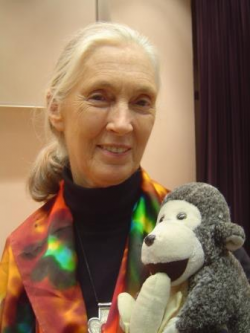Dr Dame Jane Goodall

- Born
- 3 April 1934
Dr Dame Jane Goodall’s decades of studying Pan troglodytes (wild chimpanzees) in Tanzania have revolutionised how we think about both chimpanzees and ourselves. She established what is now the longest running field research project into chimpanzees and is a campaigner for people, wildlife and the environment.
Dr Goodall has always been fascinated by animals. At the age of four, she hid in a hen house for hours, watching how hens laid eggs, while her family searched anxiously and reported her missing to the police. She founded her own nature club at the age of 12. It was her childhood dream to go to Africa and write books about animals. When a friend invited her to visit the family farm in Kenya in 1956, she jumped at the chance and worked as a waitress to raise money for the boat fare.
Once there, she took a job working in an office, and met the anthropologist and palaeontologist Dr Louis Leakey, who hired her as his secretary. She accompanied Leakey and his wife on paleontological expeditions to the Serengeti Plains.
Leakey was taken with her enthusiasm and asked if she would be interested in a job observing a community of chimpanzees. Remains of prehistoric man had been found close to the community and Leakey thought that observing their behaviour would shed light on how our stone age ancestors behaved, as chimpanzees are our closest relatives in the animal world. Goodall did not have a degree but Leakey saw this as an advantage, wanting someone who would not observe with any previous theories, but only with the desire for knowledge and a sympathy for the animals.
Goodall first arrived at the Gombe Stream game reserve in Tanzania in 1960, at the age of 26. Her mother accompanied her as the British Government insisted that she take a companion with her (Tanzania was a British protectorate at the time). Her only equipment was a notebook and pair of binoculars. She lived in very basic conditions and survived malaria.
Now we must redefine tool, redefine Man or accept chimpanzees as humans.
Dr Lewis Leakey
At first the chimpanzees ran away whenever she tried to observe them, but she was persistent and eventually they allowed her to get close to them. She observed previously unknown chimpanzee behaviour such as meat eating, hunting and tool making. The chimpanzees stripped the leaves from twigs in order to use them as tools to get termites out of their mounds. Until her discoveries, tool making was believed to be unique to humans.
Leakey arranged for Goodall to do a PhD in ethology at Cambridge and she later continued her research at Gombe Stream. However, she became increasingly aware of how people were struggling to survive and often destroying surrounding forests in the process.
Today, Dr Goodall’s work is focused on protecting chimpanzees and other species. Her work recognises that conservation cannot be achieved without taking an holistic approach that meets the needs of local communities. In the UK she has established a Roots and Shoots group, which works in hundreds of schools to inspire young people to take action for people, animals and the environment.



